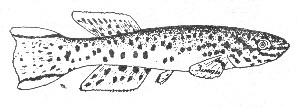Udegi

Drawing of wild fish labelled
Odegi.
Drawing by Terry Lelliot from BKA Killinews 288 (Sept.1989).
|
Codes
|
None known. | ||||||
|
History
|
Collected
by Clive Charlton in 1988 in an area he originally named Odegi. This has
later been established as being Udegi from conversations with the author
by Roger Gladwell & Odegi should be considered to be a corruption.
Situated about 14 miles west of Rafin Gabos ( East River in the Housa
language ). This area is 30 miles southwest of Lafia. Wild caught specimens measured 30 mm. Udegi is situated southeast of Abuja & northeast of Lokoja. |
||||||
|
Habitat
|
Located at the headwaters of the Kerko River. These fish were found in shallow streams ( 6" ) running off dams. | ||||||
|
Images
|
The following images are deviations or developments from wild stock bred by Roger Gladwell (BKA).
|
||||||
|
Traits
|
|||||||
|
Variability
|
Around
12 males were collected & brought back to the UK. All showed the same
colour patterning. Later generations however produced variable fish. |
||||||
|
Notes
|
Notes on colouration in K/N 280, January 1989.
'basic body colour blue, darker dorsally. Body markings red. Margins
to unpaired fins yellow, submarginal lines to caudal red. Red spots
to all fins'. In BKA newsletter 288, September 1989 Brian Sell
remarked on how the fish would not spawn in top mops but would in bottom
mops. Preserved specimens of this collection were sent to the British Museum of Natural History. |